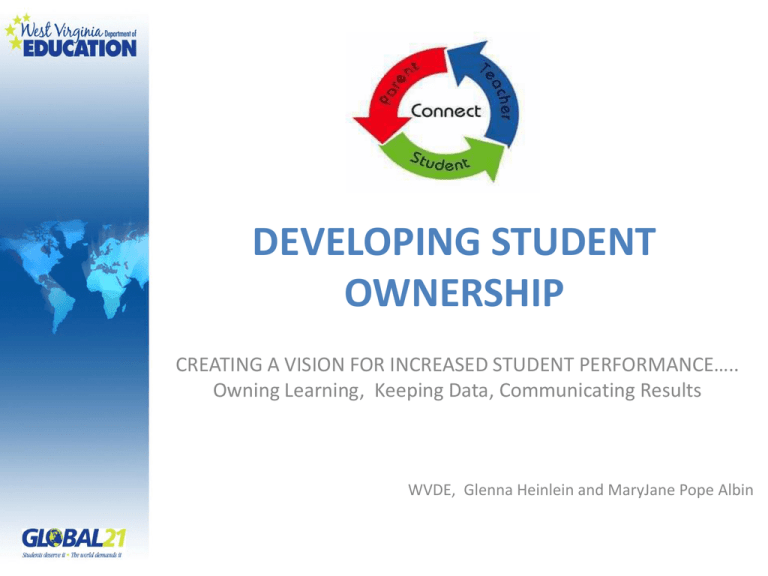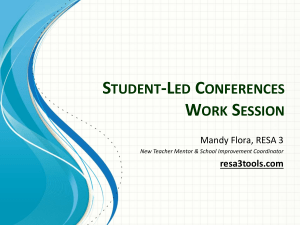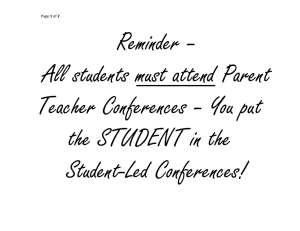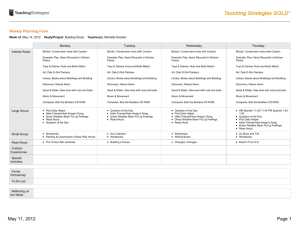DEVELOPING STUDENT OWNERSHIP
advertisement

DEVELOPING STUDENT OWNERSHIP CREATING A VISION FOR INCREASED STUDENT PERFORMANCE….. Owning Learning, Keeping Data, Communicating Results WVDE, Glenna Heinlein and MaryJane Pope Albin Everyone is a Winner • Have you experienced student motivation problems this year? • Are you interested in students taking a more active role in their learning? • Would you like students to take more ownership for their work? • Are you concerned about students behavior? Begin With The End in Mind • • • • • • • Data talks Data Walls Data tracking Student data notebooks Portfolios Parent participation Student led conferences Student Ownership of their Learning Numbers as data • “Numbers alone mean nothing. The right numbers interpreted well, – provide information to evaluate effectiveness of improvement efforts, – guide our practice, and ultimately transform our lowest performing schools into places with high levels of learning for both students and adults” (Huff, 2008, p. 197). What are the results when you use Data Walls • Designed to – Spur conversations – Are the discussion points for collaborative sessions and goal setting – Drive the work of school improvement – Demonstrate focus on the school’s SMART Goals – Link improvement to measurable data that shows student improvement – Focus The most important outcome is that the data walls are the focus of conversation and actions • Types – Public Data Walls - multiple forms of data • external • Attendance • Discipline • Summative achievement data • Interim or benchmark data • Progress monitoring – Individual or private data walls are used by teams of teachers to • Internal • Track individual student attendance • Monitor behavior • Review progress toward summative achievement data • Interim or benchmark data for individual student progress • Individual progress monitoring • • Conversations and Actions – display of data intended to spur conversation about improvement toward goals – dynamic and regularly updated – messaging is informative and encourages action – often supported with contests and recognition Conversations and Actions – Display of data for conversations about interventions – Continuous progress reporting – Individual student interventions – Scheduling – Before school/after school programming. DATA Walls More Than a Graphic Representation Goal setting to improve student learning. Photo credit: David Binder Encouraging Progresspractice • Improvement Goal 10-8 – Decrease disengagement time by improving transitions – Increase higher order thinking activities in all classes • • • • 5 and 6 2 and 3 4, 5, 6 1, 2, 3 Ansted Elementary Students charting their own progress Photo credit: David Binder Research-TRANSPARENCY Many schools with a Clear and Common Focus make their goals and progress transparent to the community through the display of data walls and data graphs. Whether they are hand-drawn or computer-generated, these data displays show students, parents, teachers, and other community members the students’ progress toward greater achievement Douglas Reeves High School Data Wall Example What are the results when you set goals from data? What data can you use? • build shared ownership, accountability, and awareness of progress toward goals • reinforce positive messaging to school community instill goal setting IMPROVE STUDENT OUTCOMES! Boston Public Schools Student Data Folios • Test Talks or conversations • Students set goals to their learning Cole discusses his skills Goal Setting • The ability to improve one’s result depends on the ability to adjust one’s pace in light of ongoing feedback that measures performance against a concrete, long term goal. • If I am not clear on my goals or if I fail to pay attention to them, I cannot get helpful feedback. Grant Wiggins 7 Keys to Effective Feedback Jigsaw the article • Expert Groups – #1 pp 11-12 – #2 pp 13-14 – #3 pp 15-16 • Use a T chart or 2 column notes to: – State the important points; how we can use this – http://www.learner.org/jnorth/tm/InstrucStrat19.html • Table Group Discussion • Group comments on chart paper • Report out http://www.readingrockets.org/strategies/jigsaw Student led conferences could help you put students on “center stage” and take more responsibility for their academic achievement and selfdiscipline PHILOSOPHY Student led conferences reflect the belief that students should be actively involved in their learning and assume responsibility for the learning process. Through student led conference, students become more motivated, reflective and evaluative. They also become more critical in their approach to learning. Traditional vs. Student-Led • Teacher Driven • Short time frame – little time for conversations • Focus tends to be on social and emotional rather than academic • Fragmented • Student driven • Longer time – conversation based • High accountability • Opportunities for goal setting • Samples of work • Authentic assessment Benefits vs. Pitfalls Activity: • table discussion about implementing student-led conferences • list likely benefits • list potential pitfalls • report out • chart PURPOSE • Students accept responsibility for learning, become more aware of the learning process, and track their own data. • They report academic growth to parents and progress toward becoming life long learners. POWER Student led conferences… • Encourage students to take an active role in their learning • Motivate students to take more ownership for their work • Allow students to see their progress over time • Encourage students to evaluate their work POWER Student led conferences… • Encourage students, parents and teachers to openly communicate as equal partners about student achievement • Enhance students’ oral communication skills • Build students’ self-confidence • Build relationships POWER Student led conferences… • Increase parent participation in conferences • Move students toward goal of being life long learners • Focus discussion on priority standards and their accomplishment • Showcase student work • Encourage students, parents and teachers to engage in open, honest, dialogue POWER Student led conferences… • Press students to have a vision for their future • Utilize students strengths, and interests to garner higher student achievement • Facilitate the development of students oral communication skills • Encourage self-efficacy 10 Good Reasons to Implement Student-Led Conferencing • Opens up communication between school and home • Practices real life-skills - communication, organization, leadership, etc. • Teaches self-evaluation, self-reflection skills • Focuses on learning • Goal setting process has buy-in by all involved Con’t: 10 Good Reasons to Implement Student-Led Conferencing • Easier scheduling - easily accommodates late arrivals, walk-ins • Provides quality time between parent and child • Less stress on teacher during conference days • Accommodates parents who do not speak English • Students are the center of the conference Organizing for the Conferences • When to hold – time of year • Decide on overall organizational plan – facilitators, drop-ins, set up, demos • How many to hold at a time – structure • Decide upon scheduling process • Parent notification process • Preparing teachers • Preparing students – teach the script and process NUTS AND BOLTS Before the conference…. 1. Begin with student goal setting 2. Prepare samples of students work to show evidence of growth and goal progress (data notebooks and portfolio). 3. Notify parents well in advance of the conferences. 4. Provide opportunities for students to practice NUTS AND BOLTS (1) Goal setting • Identify strengths and challenges based upon data…WESTEST, Benchmarks, Grades, classroom assessment and performance, behavior, attendance, inventories, self assessments, parent assessment, teacher assessment, etc. NUTS AND BOLTS (1) Goal setting Set goals with the grade level cluster/mathematical standards in mind ... Reading, Writing, Mathematics, Science, Social Studies Design a plan of action… student responsibilities, teacher responsibilities, parent responsibilities Decide on evidence to be included in portfolio, and from data notebook… what shows progress toward achieving the goals NUTS AND BOLTS (2) Prepare samples of students’ work to show evidence of growth and goal progress (portfolio). Include baseline evidence • • • • • • WESTEST Benchmarks Classroom Assessment Writing Assessments Inventories/Self Assessments Etc….. Have students organize their work with a table of contents Have students to explain and reflect upon their choices(post-its or note cards) • • • I put this in my portfolio because… I feel good about this piece because… If I did this piece again, I would improve it by… NUTS AND BOLTS (3) Notify parents will in advance of the conference. Send home a letter explaining the conference format and why it is being used… • • • • Why are you having student led conferences? How will the conferences be different? If necessary, when can parents talk to you without the student? When and where will the conference be held? Develop parent conferencing questions to guide parents through the process….. NUTS AND BOLTS (4) Provide opportunities for students to practice…. Model the process • • Teacher to teacher Teacher to teacher assistant With students, develop a checklist describing student role Organize student to student practice sessions NUTS AND BOLTS Conference Checklist Students Parents Teacher NUTS AND BOLTS Conference Schedule Example 1. 2. 3. 4. 5. 6. 7. Introduction (1 minute) Orientation (2 minutes) Students Achievement Data (5 minutes) Students Goals (3 minutes) Action Plan (5 minutes) Students Work (10 minutes) Debriefing (2 minutes) NUTS AND BOLTS 1. 2. 3. 4. 5. 6. 7. Introduction-students intros parent to teacher Orientation-teacher explains conf. procedure Student Achievement Data-examining the datateacher shares data that helped identify the goals Student Goals-student shares goals and explains why they were selected Action Plan-student and teacher discuss their responsibilities and plan Students Work-student shows work and reflections from the portfolio to demonstrate his/her progress toward goal achievement Debriefing-student, teacher, and parent discuss and comment on the conference process NUTS AND BOLTS Conference Organizer While we look at my work, please notice these things: • Subject goal ________ • Steps I will take to reach goal • • • • 1. 2. 3. _____________ _____________ _____________ How parents can help me reach the goal _____ Plan to monitor progress _______ These are the things I do well ______ These are the things I am working on ______ NUTS AND BOLTS After the Conference 1. Student sends thank you letter to parent 2. Student completes reflection survey 3. Parent questionnaire/evaluation NUTS AND BOLTS • • • • Student Reflection Survey Example What did you like about the student led conference? How did you feel during the conference? What didn’t you like about the conference? If you could change the conference to make it better, what would you do? NUTS AND BOLTS • Parent Questionnaire Example Which conference (traditional or student led) gave you a better appreciation of… – – – What your child was learning? What your child studied in class? Your child’s study habits such as finishing assignments and handing work in on time? NUTS AND BOLTS • • • • Parent Questionnaire Example Which conference format did you prefer? Why? What are the benefits of student led conferences? What are the disadvantages of student led conferences? What more would you like to learn in the conference? KEYS TO SUCCESS • Students and teachers willing to take risks • Teachers willing to step aside • Focusing in on student achievementNext Gen Standards and their accomplishment • Committing to the process • Learning • Preparing • Practicing CHALLENGES • • • • • • First time jitters Uncertainty of sharing control with students Need to adopt a student-centered philosophy Organizing the logistics of conferences Responding to families who don’t participate Vision of the student for their academics and their future THE ROLE OF VISION • • • • Vision is a dream in action Vision gives direction Vision determines your destination Vision always precedes great performance or action THE ROLE OF VISION • Vision clarifies purpose • Vision empowers students beyond known assets VISION…. Enables Empowers Enhances THE FUTURE-FOCUSED ROLE IMAGE Successful students had: • A vision of their future • Goals • Believed in their own self-efficacy • Saw multiple options in their life SUMMARY Teacher benefits: • • • • • Less stress on teachers, very relaxed atmosphere Less confrontational (more positive) Places responsibility on the student and parent Increased parent participation An opportunity to see students in a leadership role SUMMARY Parent benefits: • Increases the amount of information given to a parent • Learn more about their child’s learning and skills • An opportunity to help their child set positive goals • Active participant in their child’s learning • First language communication • Eliminates standing in line for a conference • Allows for more time in their child’s learning environment to see what the child has worked on over a period of time • First hand opportunity to see their child in charge of the learning process SUMMARY Student benefits: • Accountability for their learning • Students learn to evaluate their own progress • Students gain greater commitment to school work and learning • Builds self confidence and self-esteem • Encourages student/parent communication • Builds communication and critical thinking skills • Places responsibility on the student and parent • Allows students to become involved • Puts students in charge of their learning • Time allowed to share and celebrate in learning environment




![[Today’s Date] [Your Supervisor’s First Name] [Your School or District’s Name]](http://s2.studylib.net/store/data/010451343_1-ed5410b4013e6d3fbc1a9bbd91a926a9-300x300.png)
